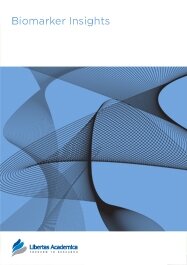

Publication Date: 16 Oct 2007
Journal: Biomarker Insights

1Department of Obstetrics and Gynecology, University of California, Los Angeles, CA 90095, U.S.A. 2Pathway Diognostics, Inc. Malibu, CA 90265, U.S.A. 3Biomathematics and Human Genetics, 4Biostatistics, School of Public Health, 5Medicine, and Departments of 6Molecular and Medical Pharmacology, University of California, Los Angeles, CA 90095, U.S.A.
Abstract
Objective: We have previously analyzed protein profi les using Surface Enhanced Laser Desorption and Ionization Time-Of-Flight Mass Spectroscopy (SELDI-TOF-MS) [Kozak et al. 2003, Proc. Natl. Acad. Sci. U.S.A. 100:12343–8] and identified 3 differentially expressed serum proteins for the diagnosis of ovarian cancer (OC) [Kozak et al. 2005, Proteomics, 5:4589–96], namely, apolipoprotein A-I (apoA-I), transthyretin (TTR) and transferin (TF). The objective of the present study is to determine the efficacy of the three OC biomarkers for the detection of early stage (ES) OC, in direct comparison to CA125.
Methods: The levels of CA125, apoA-I, TTR and TF were measured in 392 serum samples [82 women with normal ovaries (N), 24 women with benign ovarian tumors (B), 85 women with ovarian tumors of low malignant potential (LMP), 126 women with early stage ovarian cancer (ESOC), and 75 women with late stage ovarian cancer (LSOC)], obtained through the GOG and Cooperative Human Tissue Network. Following statistical analysis, multivariate regression models were built to evaluate the utility of the three OC markers in early detection.
Results: Multiple logistic regression models (MLRM) utilizing all biomarker values (CA125, TTR, TF and apoA-I) from all histological subtypes (serous, mucinous, and endometrioid adenocarcinoma) distinguished normal samples from LMP with 91% sensitivity (specifi city 92%), and normal samples from ESOC with a sensitivity of 89% (specifi city 92%). MLRM, utilizing values of all four markers from only the mucinous histological subtype showed that collectively, CA125, TTR, TF and apoA-I, were able to distinguish normal samples from mucinous LMP with 90% sensitivity, and further distinguished normal samples from early stage mucinous ovarian cancer with a sensitivity of 95%. In contrast, in serum samples from patients with mucinous tumors, CA125 alone was able to distinguish normal samples from LMP and early stage ovarian cancer with a sensitivity of only 46% and 47%, respectively. Furthermore, collectively, apoA-I, TTR and TF (excluding CA-125) distinguished i) normal samples from samples representing all histopathologic subtypes of LMP, with a sensitivity of 73%, ii) normal samples from ESOC with a sensitivity of 84% and iii) normal samples from LSOC with a sensitivity of 97%. More strikingly, the sensitivity in distinguishing normal versus mucinous ESOC, utilizing apoA-I, TF and TTR (CA-125 excluded), was 95% (specifi city 86%; AUC 95%).
Conclusions: These results suggest that the biomarker panel consisting of apoA-I, TTR and TF may significantly improve early detection of OC.
PDF (307.19 KB PDF format)
RIS citation (ENDNOTE, REFERENCE MANAGER, PROCITE, REFWORKS)
BibTex citation (BIBDESK, LATEX)
XML
PMC HTML
Publishing in Air, Soil and Water and Water Research was the best experience I have had so far in an academic context. The review process was fair, quick and efficient. I congratulate the team at Libertas Academica for a very well managed journal.Magnus Karlsson (IVL Swedish Environmental Research Institute, Stockholm, Sweden) What Your Colleagues Say
Copyright © 2012 Libertas Academica Ltd (except open access articles and accompanying metadata and supplementary files.)
FacebookGoogle+Twitter
PinterestTumblrYouTube